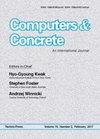Effect of infill wall properties on seismic response of RC structures
IF 3.3
4区 工程技术
Q2 COMPUTER SCIENCE, INTERDISCIPLINARY APPLICATIONS
引用次数: 2
Abstract
Brick infill walls (BIW) have significant effects on reinforced concrete (RC) structures' seismic performances. However, mechanical effects on the structural performance of BIWs, which are regarded as only weight at the design stage, are not considered in many seismic codes. Therefore, seismic performances of new and existing RC structures could not be realistically obtained. This study aims to investigate the effects on the structural behavior of BIWs, stucco types, and soft story. RC structures with and without BIWs are modeled by using the SAP2000 program. BIW is modeled with the equivalent diagonal compression strut method, and mechanical properties of BIWs plastered with conventional and polypropylene fibrous stuccos are taken from literature. Seismic performances of all structures are investigated using the pushover analysis method, according to Turkish Seismic Code-2007 (TSC-2007) principles. Besides, natural periods, rigidities, ductilities and energy dissipation capacities of all structures are obtained. As a result of analyses, it is determined that BIWs have significant effects on structural performances in terms of rigidity and ductility, and fibrous stucco considerably increases RC structures' rigidity and ductility. These walls can even lead to the collapse of structures in severe earthquakes if design engineers don't regard BIWs or BIWs are placed as asymmetric or deficient on the structure.填充墙性能对钢筋混凝土结构地震反应的影响
砖填充墙对钢筋混凝土结构的抗震性能有重要影响。然而,在设计阶段只考虑重量的BIWs结构性能的力学影响,在许多抗震规范中没有考虑。因此,新建和既有钢筋混凝土结构的抗震性能不能真实地得到。本研究旨在探讨灰泥种类和软层对白墙结构性能的影响。采用SAP2000软件对带和不带biw的RC结构进行建模。采用等效对角压缩支撑法对白车身进行建模,采用常规灰泥和聚丙烯纤维灰泥对白车身进行力学性能分析。根据土耳其抗震规范2007 (TSC-2007)的原则,使用推覆分析方法对所有结构的抗震性能进行了研究。得到了各结构的自然周期、刚度、延性和耗能能力。分析结果表明,砌体在刚度和延性方面对结构性能有显著影响,纤维灰泥显著提高了RC结构的刚度和延性。如果设计工程师不考虑BIWs或BIWs放置在结构上的不对称或缺陷,这些墙甚至可能导致结构在强烈地震中倒塌。
本文章由计算机程序翻译,如有差异,请以英文原文为准。
求助全文
约1分钟内获得全文
求助全文
来源期刊

Computers and Concrete
工程技术-材料科学:表征与测试
CiteScore
8.60
自引率
7.30%
发文量
0
审稿时长
13.5 months
期刊介绍:
Computers and Concrete is An International Journal that focuses on the computer applications in be considered suitable for publication in the journal.
The journal covers the topics related to computational mechanics of concrete and modeling of concrete structures including
plasticity
fracture mechanics
creep
thermo-mechanics
dynamic effects
reliability and safety concepts
automated design procedures
stochastic mechanics
performance under extreme conditions.
 求助内容:
求助内容: 应助结果提醒方式:
应助结果提醒方式:


